Cabergoline: instructions for use
Pharmacodynamics
Dopamine-stimulating agent, ergoline derivative, reduces STH hypersecretion, suppresses prolactin secretion.
Stimulates dopamine D2-receptors of lactotropic cells of pituitary gland; in high doses it has central dopaminergic effect. Normalises prolactin content in the blood, restores menstrual cycle and fertility. By reducing the concentration of prolactin in the blood in women, it restores pulsatile gonadotropin secretion and LH release in the middle of the cycle, eliminates anovulatory cycles and increases the concentration of estrogen in the body, reduces the severity of hypoestrogenic (weight gain, fluid retention, osteoporosis) and hyperandrogenic (acne, hirsutism, etc.) symptoms.
In men it decreases decrease in libido, impotence caused by hyperprolactinaemia (as prolactin concentration decreases, testosterone level increases), gynaecomastia, reduction and softening of testicles, lactorrhoea. Pituitary macroadenomas and related symptoms (headache, disturbance of visual fields and acuity, functions of cranial nerves and anterior lobe of pituitary gland) are reversed.
Reduces prolactin concentration in patients with prolactinoma and pseudoprolactinoma (in the latter – without reducing the size of pituitary adenoma).
Suppresses STH release by pituitary adenoma and reduces visual disturbances, neurological disorders and severe headaches, inhibits the progression of acromegaly. It causes clinical improvement in 70-90% of patients, but at the end of the course the content of STH in the blood increases again.
Stimulation of dopamine receptors restores neurochemical balance in the area of the striatum and the black nucleus of the brain, which contributes to the alleviation of depressive symptoms, tremor and rigidity, acceleration of movements at all stages of Parkinson’s disease. Decrease in prolactin concentration is noted 3 h after administration and persists for 7-28 days in patients with hyperprolactinaemia and 14-21 days – when suppressing postpartum lactation. Normalisation of prolactin concentration occurs within 2-4 weeks of treatment.
Pharmacokinetics
Absorption – high, does not depend on food intake. TCmax – 0.5-4 h; binding to plasma proteins – 41-42%. T1/2 – 63-68 h in healthy subjects and 79-115 h in patients with hyperprolactinaemia. Css is reached after 4 weeks of therapy. AUC is increased in patients with severe hepatic impairment (Child-Pugh class C). Excreted mainly with faeces, as well as by kidneys (3% in unchanged form).
INDICATIONS
- Postpartum lactation (prevention or suppression);
- treatment of disorders associated with hyperprolactinaemia (amenorrhoea, oligomenorrhoea, anovulation, galactorrhoea),
- prolactin-secreting pituitary adenomas (micro- and macroprolactinomas);
- idiopathic hyperprolactinaemia;
- empty Turkish saddle syndrome in combination with hyperprolactinaemia.
CONTRAINDICATIONS
Hypersensitivity (including to other ergot derivatives), lactation period.
With caution
Severe SSc diseases, Raynaud’s syndrome, severe hepatic insufficiency, peptic ulcer, gastrointestinal bleeding, severe psychotic and cognitive disorders (including in the anamnesis), arterial hypertension developed against the background of pregnancy (pre-eclampsia) and postpartum arterial hypertension, childhood age (under 16 years of age – safety and efficacy of use have not been established).
SIDE EFFECTS
Moderately pronounced, appear within the first 2 weeks and pass independently.
- Nervous system: dizziness, vertigo, headache, increased fatigue, drowsiness, depression, asthenia, paresthesias, syncope.
- Digestive system: nausea, vomiting, epigastric pain, abdominal pain, constipation, gastritis, dyspepsia. SSc: asymptomatic decrease in BP (during the first 3-4 days after delivery), palpitations; rarely – orthostatic hypotension.
- Other: mastodynia, nose bleeding, “flushes” of blood to the skin of the face, transient hemianopsia, vasospasm of the fingers, cramps of the muscles of the lower limbs, alopecia, increased activity of CPK, mania, dyspnoea, oedema, pleural fibrosis, pleural effusion, valvulopathy, respiratory disorders (including respiratory failure), liver dysfunction.
- Allergic reactions: skin rash,
Overdose
- Symptoms: nausea, vomiting, abdominal pain, constipation, decreased BP, orthostatic hypotension, headache, cramps in calf muscles, acute asthenia, sweating, drowsiness, psychomotor agitation, psychosis, hallucinations, impaired consciousness.
- Treatment: gastric lavage, BP control, administration of dopamine antagonists (phenothiazine derivatives, butyrophenone, thioxanthene, metoclopramide).
Interaction with other drugs
- Macrolides (including erythromycin) increase the risk of side effects (increase the drug concentration in plasma).
- Phenothiazine derivatives, butyrophenone, thioxanthene, metoclopramide reduce the effect.
- Combination with ergot alkaloids and their derivatives is not recommended.
SPECIAL INSTRUCTIONS
Before prescribing the drug for the treatment of disorders associated with hyperprolactinaemia, it is necessary to perform a complete study of pituitary function.
When increasing the dose, patients should be under the supervision of a physician in order to establish the lowest effective dose that provides therapeutic effect.
Once an effective dosing regimen is selected, it is recommended to perform regular (once a month) determination of serum prolactin levels. Normalisation of prolactin is usually observed within 2-4 weeks of treatment.
After cancelling cabergoline, relapse of hyperprolactinaemia is usually observed, but in some patients there is a persistent suppression of prolactin levels for several months. In most women, ovulatory cycles persist for at least 6 months after cancellation of the drug.
Pleural effusion/pleural fibrosis and valvulopathy have been observed in patients after long-term administration of cabergoline. In some cases, patients received prior therapy with ergotinine dopamine agonists. Therefore, cabergoline should be used with caution in patients with current manifestations and/or clinical symptoms of cardiac dysfunction, including history. After discontinuation of cabergoline, patients diagnosed with pleural effusion/ pleural fibrosis and valvulopathy showed improvement of symptoms. The use of cabergoline causes drowsiness. In patients with Parkinson’s disease the use of dopamine receptor agonists may cause sudden falling asleep. In such cases it is recommended to reduce the drug dose or discontinue therapy.
Studies on the use of the drug in elderly patients with disorders associated with hyperprolactinaemia have not been conducted. Cabergoline restores ovulation and fertility in women with hyperprolactinaemic hypogonadism. Since pregnancy may occur before menstruation is restored, it is recommended to perform pregnancy tests at least once every 4 weeks during amenorrhoea, and after menstruation is restored – every time menstruation is delayed for more than 3 days. Women who wish to avoid pregnancy should use barrier methods of contraception during treatment with the drug, as well as after its cancellation until recurrence of anovulation. Women who become pregnant should be under the supervision of a doctor for timely detection of symptoms of pituitary enlargement, because during pregnancy it is possible to increase the size of pre-existing pituitary tumours. Patients taking cabergoline, who experience drowsiness, should be warned that it is recommended to refrain from driving and from work requiring increased concentration and quick psychomotor reactions.
Showing all 13 results
-
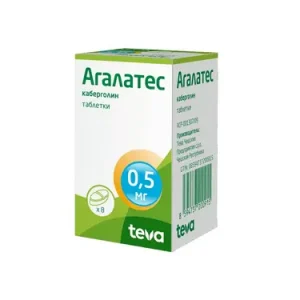
Agalates 0,5 mg (2 tab) TEVA
7,00 € Add to cart -

Agalates 0,5 mg (8 tab) TEVA
10,86 € Add to cart -
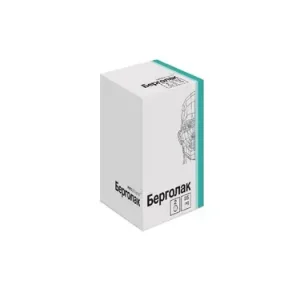
Bergolac 0,5 mg (2 tab) Veropharm LLC
5,00 € Add to cart -
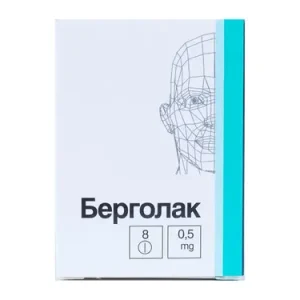
Bergolac 0,5 mg (8 tab) Veropharm LLC
25,80 € Add to cart -

Cabergolin 0.5 mg (2 tab) Obninsk
4,00 € Add to cart -

Cabergolin 0.5 mg (8 tab) Obninsk
15,00 € Add to cart -

Cabergolin-ratiopharm® 0.5 mg
9,86 € Add to cart -
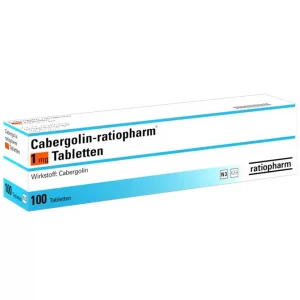
Cabergolin-ratiopharm® 1 mg
10,00 € Add to cart -
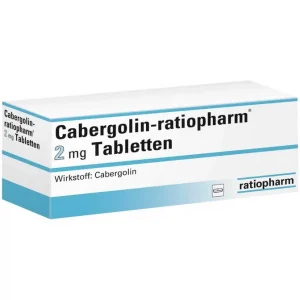
Cabergolin-ratiopharm® 2 mg
10,00 € Add to cart -

Cabergolin-TEVA® 0,5 mg
9,86 € Add to cart -
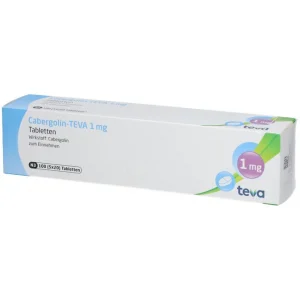
Cabergolin-TEVA® 1 mg
10,00 € Add to cart -

Cabergolin-TEVA® 2 mg Teva
10,00 € Add to cart -

Dostinex 0,5 mg EurimPharm
5,00 € Add to cart